|

 Up
Up 
 Landed Gentry
Landed Gentry

(You are here.)



  Need
to Need
to
find your
bearings?
Try
these
navigation aids:
If
this is your first
visit, please stop by:
Something
to share?
Please:



|
|
Available in Française, Espańol, Portuguęs, Deutsch, Россию,
中文,
日本, and others.
Sir John Wright, Lord of Kelvedon
Hall, circa 1485 to 1551
Sir John Wright was born in Dagenham, Essex
County, England. He married Olive Hubbard in the South Weald Church,
Essex County (near Wrightsbridge) on 17 March 1508. Olive had also
been born in Dagenham. They had seven children – John the Elder,
Katherine, Robert, Alice, John the Myddle, John the Younger, and
Elizabeth. As Henry VIII ascended the throne, he granted John Wright
peerage on 20 June 1509, giving him a title and seat in the House of Lords. John became a
baron and took the title Sir John Wright. He was also granted a coat
of arms – an azure shield with silver bars and a leopard’s head. The
family motto was “Conscia recti,” a Latin phrase from Aeneid
meaning “a clear conscience.”
Sir John personally served King Henry VIII
during the “King’s Great Matter,” during which Henry petitioned Pope
Clement VII to annul his marriage to Catherine of Aragon. Catherine
had not produced an heir to his throne, and Henry asked the Pope to
give him leave to marry Ann Boleyn, his mistress and a lady in
Catherine’s entourage. The Pope refused, and Henry severed the
Church of England from the Roman Catholic Church in 1533. Whatever
Sir John’s role was in this event, it pleased the King and John
became a rich man for his efforts. He turned his attention to
building a suitable home for a man of his means and station.
Sometime before 1509, John had moved to
Kelvedon Hatch with his father. The Doomsday Book, a census ordered
by King William I in 1086, mentions Kelvenduna, a feudal
estate lorded over by a Saxon soldier/sailor, Aethelric. It’s
thought that Aethelric may have built St. Nicholas, the oldest
surviving church in the area. In 1066, Aethelric had sailed off to
fight William the Conqueror, the Wryta brothers, and other Norman
invaders. The defeated Aethelric returned to Kelvenduna and
continued as lord of the manor under William I. Not long afterwards,
however, he fell ill and died. His property passed to the church,
probably confiscated by King William, as William did with many
Saxon freeholders who fought against him. The ownership of the Kelvenduna estate passed to “St Peter” – the Norman arm of the Roman
Catholic Church headquartered in Westminster Abbey. Specifically, it
passed to Odo, the Bishop of Bayeux and William’s half-brother. This
was William’s way of keeping the spoils of war in the family.
John erected Kelvedon Hall next to the old Saxon church allegedly built by Aethelric. Its construction took 14 years, beginning in 1524. In
1538, he bought the surrounding lands – about 2000 acres – from
Richard Bolles and Westminster Abbey for ₤493. Bolles had inherited
the tenancy of the lands from his mother’s family, the Multons, who
had in turn been granted the tenancy in 1225 from Westminster Abbey.
This real estate deal reeked of politics. The transfer of lands from
the church to the loyal gentry was part of Henry’s campaign to
weaken the power of the Roman Catholic Church in England. Sir John
Wright II died in Kelvedon Hall on 5 October 1551. His wife Lady
Olive Hubbard Wright died in Kelvedon Hatch on 22 June 1560.
John (the Myddle) Wright, 1522 to
1558
Middle John Wright was born in Kelvedon Hall in
1522. According to his father’s will, executed in 1551, “To my son
called Myddle John I give all the land I have in Havering and houses
and millers house and a tenement in Childerditch wherein Gibbes doth
dwell.” This was the area where the bridge that the Wrights
had tended for centuries spanned the Ingrebourne River. The land was known as Wrightsbridge,
and the
manor house and estate was referred to both as Wrightsbridge Manor
and Dagenham Manor.
During his time, Englishmen identified each
other less and less as Norman and Saxon and became much more
concerned with who was Catholic and who was Protestant (Anglican).
Middle John and his siblings were mostly Protestant, their father
having supported Henry VIII’s break with Rome. But in 1553, just
before Middle John’s death, Henry VIII’s daughter Mary I (1553-1558)
came to the throne and pressed for England to return to Catholicism.
She was ruthless in this endeavor, had over 280 Protestant
dissenters burned at the stake, and earned the sobriquet “Bloody
Mary.” Fortunately for the Wrights and other Protestants, her reign
was short and the persecution ended when her Protestant sister
Elizabeth I (1558-1603) came to the throne. But it was a harbinger
of things to come; the tensions between religious sects in England
continued to grow.
Middle John married Alice Rucke of Kelvedon
Hatch in 1541. They had six children, Dorothy, John, Mary, Olive,
Agnes, and Robert. Middle John died in Wrightsbridge in 1558 when he
was just 36 years old. His wife Alice did not live much longer; she
died in 1560.
Lord John Wright of
Wrightsbridge,
1548 to 1624
Middle John’s first son, John Wright, was born
in 1548 and inherited the Wrightsbridge lands and Dagenham Manor
when he was just 10 years old. He was granted peerage by Queen
Elizabeth I (1558-1603) in 1590 and given a seat in the House of
Lords. He was married twice, the first time to Elizabeth Linsell
about 1568. She bore him three sons and two daughters – John,
Samuel, Jane, Nathaniel, and Elizabeth. His first wife died in 1589
and John married Bennett Greene in 1590.He had three more children
with her – Lawrence, Bennett, and William.
They lived in auspicious times, Elizabethan
England was a foment of new ideas and opportunities. Francis Bacon
codified the Scientific Method, William Harvey mapped the
circulatory system, and Sir Francis Drake sailed around the world.
In 1587, the English took an interest in colonizing America and
finally succeeded in 1607. The King James Bible was published in
1611, making this book available in English for the first time.
England’s agrarian economy expanded to include large-scale
manufacturing and global trade. Young men left the rural manors and
filled the cities, becoming doctors, lawyers, and merchants. From
these new urban professionals emerged a literate middle class who
devoured the plays of Shakespeare and the books of Milton and loudly
debated the finer points of politics, philosophy, and religion.
Among these new ideas was Puritanism. Henry
VIII’s break with the Pope had been welcome in England not because
the English wanted their King to have his marriage annulled, but
because of the excesses and the failures of the Catholic Church. The
Church of England was the beginning of the Reformation in England,
but many felt it did not reform enough. The Anglican church retained
much of the pomp and ceremony of the Catholic church it had
replaced. More important, the rigid clerical hierarchy remained –
the King and had simply replaced the Pope. Moreover, English
protestants who fled to other countries during the reign of Mary I
brought back to England the ideas of John Calvin and other
contemporary theologians. This stew of religious ideas gave rise to
the Puritans, who emerged
largely from the new English middle class. As a group, they proposed less pomp and more
substance. They rejected the hierarchy and the notion of a supreme
spiritual leader to whom they owed allegiance. They wanted their
congregations to have more autonomy and their God to be more
accessible. At least two of Lord Wright’s sons, John and Nathaniel,
had strong Puritan leanings.
Lord John Wright died at Wrightsbridge in 1624
as the Puritan movement reached its strongest ebb – and a year
before they faced their greatest challenge.
John Wright, Esq., 1569 to 1640
John Wright was born in 1569 at Wrightsbridge,
Essex County, England. Although firstborn, there is no record that
he inherited the Wrightsbridge lands or Dagenham manor. Instead, he
seems to have had a successful career in London. He graduated from
Emmanuel College at Cambridge University (a hotbed of Puritan
radicals) in 1593 and was admitted as a barrister to Gray’s Inn (an
influential legal association) in 1598, and began a clerkship in the
Courts that same year. He married Martha Castell in 1594, and they
had four sons – John, Nathaniel, Samuel, and Robert. Martha died in
1610 and John remarried to Fortune (Garraway) Blount, the widow of
Sir Edward Blount, in 1618. John and Fortune had one child, James.
In 1612 John Wright, Esq. was appointed a clerk
to the House of Commons. Because of this appointment – and because
he was a Puritan-leaning Protestant – he was probably at odds with
his Anglican father in the House of Lords from time to time. It was
a frustrating time for any member of the government; King James I
(1603-1625) steadfastly refused to share any real power with
Parliament. A Parliamentary document protesting the actions of King
James I bears John Wright's signature on it in his capacity as clerk
of the House of Commons. This display of opposition to the King by a
family member would no doubt have embarrassed a Peer of the House of
Lords. We don’t know how well John got along with his father, but if
they had religious and political differences this may explain why
John did not inherit his father’s land, at least in part.
Goings on outside Parliament may have also
strained the relationship between father and son. While Puritans
weren’t put to death for their beliefs, they weren’t well-tolerated
by Anglicans. They were blocked again and again from making reforms
to the Church of England and some Anglican bishops openly oppressed
Puritan-leaning ministers and congregations. Anti-Puritan sentiment
within the government and the Church of England was controlled under
King James I (1603-1625), but it was unleashed when his son Charles
I (1625-1649) took the throne. He permanently dissolved the
Parliament in 1629 and what had been an extremely difficult situation
for Puritans in England became hopeless. Puritans began to emigrate
to less hostile lands. In 1630, Puritans obtained a royal charter to
form the Massachusetts Bay Colony. John’s brother Nathaniel was a
charter member and 1/8 owner of the Arabella, flagship of the
fleet that carried Puritans to the New World. John’s son Samuel was
among those who sailed. John Wright, Esq. remained and died in
Dagenham in 1640, only a few years after Samuel left for America.
|
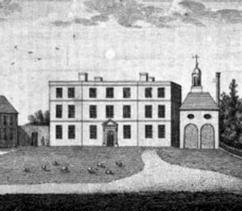
A print of Kelvedon Hall in 1777 showing St. Nicholas Church nearby.
The church was abandoned in 1895 although its ruins still stand on
the property.
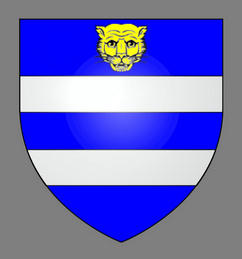
The Wright Coat of Arms, granted at the beginning of the reign of
Henry VIII. Heraldic leopards were actually lions –
"lion passant guardant" –
with their heads turned toward the observer.
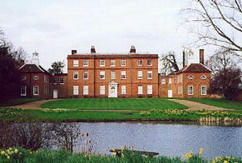
Kelvedon Hall today. The manor was purchased by American-born author
and statesman Henry Channon in 1938 and is still in the
Channon family. To visit the hall on Google Earth, click
HERE.
Photo courtesy
History House.
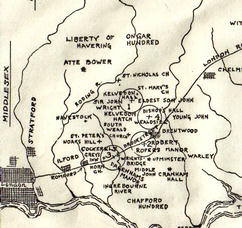
This map shows the locations of the four estates owned by Sir John
Wright. Each of his sons inherited an estate in 1551 – Middle John
got Dagenham Manor.

Queen Mary I – "Bloody Mary."
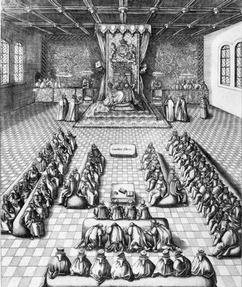
Queen Elizabeth presides over the House of Lords, Lord John Wright
somewhere amongst them. Peerage was not a taxing responsibility.
During the 45 years that Elizabeth ruled, Parliament was in session
for about 3 years all totaled.
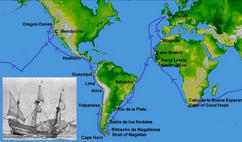
A map of the route that Sir Francis Drake took around the world with
a profile of his flagship, the "Golden Hind." Drake's voyage was
financed by Elizabeth I. During the voyage, he captured a Spanish
treasure ship and the captured gold made Elizabeth a 4700% profit on
her investment.
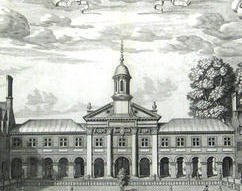
In John Wright's day, Emmanuel College was a new school in an old
building – it had been a monastery until Henry VIII confiscated the
building and grounds from the Dominican Friars. It was purchased in
1584 to house the college. John was a member of the second
graduating class.
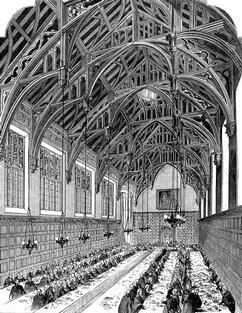
The Great Hall at Gray's Inn. Shakespeare performed here while John
was a member.
|